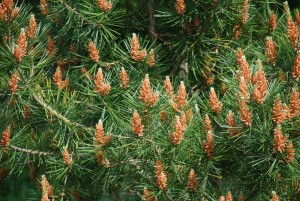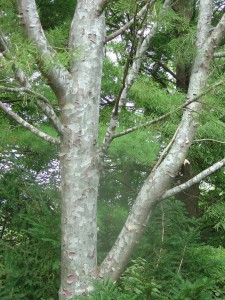Lacebark pine (Pinus bungeana) is an arboreal gem which few gardeners are privileged to own (USDA hardiness zones 4-8). Hopefully, this will change. Lacebark is a lovely 3-needle pine with exquisite exfoliating bark which becomes more attractive as it ages. Bark mottling begins after 8-10 years, that’s worth the wait if you’re a young patient gardener.
Lacebark is a 30 to 50 foot tall pine. Frequently, most gardeners start out planting an affordable 2 – 3 foot multi-branched shrub. A young lacebark starts out slow, but growth rate picks up (4-5 inches annually) after 4-5 years on-site. The lovely cinnamon colored candles tip the branches in May, similar to candles decorating a cake. When fully expanded, the 2 – 4 inch long bristly needles are sharp to the touch.
Lacebark requires no special care other than fertilizing in the early spring and mulching until it is established after 2 years. Plant lacebark in full sun and in above-average garden soil that is well-drained. An older tree is moderately drought tolerant. Occasionally, you may want prune off a few side branches to show off the exfoliating bark pattern within. Young tree bark tends to color olive green and gradually bleaches out to an oft-white many years hence.
Most potentially serious disease and insect pests may be avoided through proper siting and care. Select a visible landscape location which is frequently visited, such as near a patio, carport, driveway or a window which looks out at lacebark.
Lacebark pine can be purchased from specialty mail-order nurseries via the internet. Lacebark is a long term investment, an evergreen that you and future generations will cherish for its exquisite patchwork bark.



 Posted in
Posted in 
